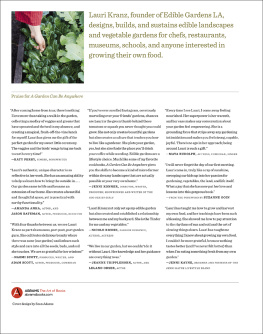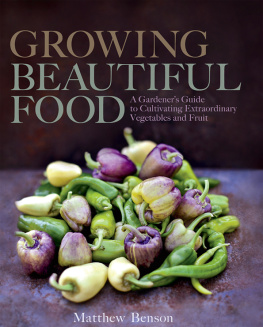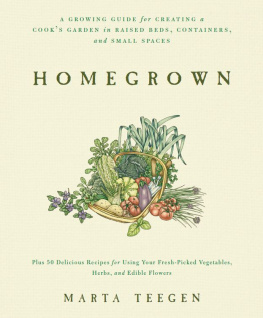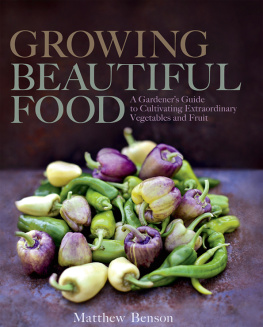

CREATING A BEAUTIFUL AND BOUNTIFUL GARDEN
WITH VEGETABLES, FRUITS AND FLOWERS
EMILY TEPE
Photography by Paul Markert

Special thanks to the organizations and individuals who graciously allowed us to photograph their gardens and landscapes: Como Park Zoo and Conservatory, Jane and Jim Gilbert, Maureen Hark, Charlene McEvoy and Doug Olson, Laura McGuire, Minnesota Landscape Arboretum, Theresa Rooney, Dawn Spraungel, and Julie Weisenhorn.
First published in 2012 by Voyageur Press, an imprint of MBI Publishing Company, 400 First Avenue North, Suite 300, Minneapolis, MN, 55401 USA
2012 by Voyageur Press
Text 2012 by Emily Tepe
All photography Paul Markert (www.markertphoto.com), except where noted.
All rights reserved. With the exception of quoting brief passages for the purposes of review, no part of this publication may be reproduced without prior written permission from the Publisher.
The information in this book is true and complete to the best of our knowledge. All recommendations are made without any guarantee on the part of the author or Publisher, who also disclaim any liability incurred in connection with the use of this data or specific details.
Voyageur Press, MBI Publishing Company, Quayside Publishing Group, their employees, and the author cannot be held responsible for any allergic reaction, illness, or injurious effect the reader may incur as a result of information contained in this book, as it is intended to provide general information only. Further, information provided herein is not designed to diagnose, prescribe, or treat illness or injury. Always consult a health-care professional or medical doctor when suffering from any health ailment, disease, illness, or injury, or before attempting any remedies. As with any natural product, plants can be toxic if misused.
We recognize, further, that some words, model names, and designations mentioned herein are the property of the trademark holder. We use them for identification purposes only. This is not an official publication.
MBI Publishing Company titles are also available at discounts in bulk quantity for industrial or sales-promotional use. For details write to Special Sales Manager at MBI Publishing Company, 400 First Avenue North, Suite 300, Minneapolis, MN, 55401 USA
ISBN: 978-0-7603-4139-1
Digital edition: 978-1-6105-8664-1
Softcover edition: 978-0-7603-4139-1
Library of Congress Cataloging-in-Publication Data
Tepe, Emily.
The edible landscape : creating a beautiful and bountiful garden with vegetables, fruits and flowers /
by Emily Tepe.
p. cm.
Includes index.
ISBN 978-0-7603-4139-1
1. Edible landscaping. 2. Landscape gardening. I. Title.
SB475.9.E35T47 2013
635.9--dc23
2012022654
Acquisitions editor: Kari Cornell
Editor: Melinda Keefe
Design manager: Cindy Samargia Laun
Designer: Sandra Salamony
Layout: Erin Fahringer
contents
preface
FOOD, GARDENS, AND A CREATIVE SPIRIT
Ill tell you right now, I am not a landscape designer. In fact, Im not even a lifelong, well-seasoned gardener. For those of you who have not put the book back on the shelf after reading those two sentences, thank you for giving me a chance to explain. I am simply a person who loves to eat fresh food and spend time outdoors growing that food. I appreciate the unique forms, textures, and colors of food plants, and I enjoy the challenge of making those plants look as delicious as they taste. I believe that anyone can and should grow some of their own food and that doing so doesnt have to mean setting aside part of the yard to be the vegetable garden. It simply means taking a look at tomatoes, cabbage, blueberries, and lettuce a little differently and giving them a place in the landscape just as you would clematis, hostas, azaleas, and impatiens. With a little creativity, and a desire to have fresh food right outside your door, I believe a yard can be both beautiful and productive.

A sturdy arbor elevates these cold-hardy grapes, creating a striking entrance to this garden. The structure exposes the plants to the sunlight, allowing the fruit to dangle within easy reach.
HEAVY ON INSPIRATION
This book isnt intended to be a how-to on every issue of planning and maintaining a garden. Rather, I hope to inspire you to grow some of your own food, right in your landscape. We will touch on a lot of factors that are important in any kind of garden: soil, light, plant nutrition, insect pests, diseases; and youll get some suggestions, opinions, and stories about things that have worked for me. What Id like to do is inspire you take note of these details and give them some thought. I hope to introduce you to or remind you why theyre important considerations for a successful garden. However, for the most part I hope to spark your imagination and get you thinking of the many exciting and attractive ways you might incorporate food plants into your landscape.
The fruit of the bell pepper plant is not only a crisp addition to salads and stir-fries but also makes a statement in the garden with its shiny, deeply colored, oblong form. The immense range of pepper varieties ensures theres something for everyone, both in terms of color in the garden and flavor on the plate.
IS IT A FRUIT OR A VEGETABLE?
Throughout this book, I sometimes refer to peppers, tomatoes, eggplants, and such as fruits. When I call them that I am referring to the parts that we eat... the actual pepper, tomato, or eggplant. I call them fruits because that is biologically what they are. Elsewhere, however, I refer to the plants as vegetables, and that is because of our cultural understanding of vegetables and fruits. In discussing various plants, and in the appendix at the back of this book, I categorize plants as vegetables, fruits, herbs, or flowers. Plants we traditionally consider vegetables are categorized as vegetables, even though the actual part we eat I call a fruit. Make sense?
NORTHERN GARDENS AND BEYOND
Having lived much of my life in the Upper Midwest, I am most accustomed to the growing conditions in this region. As Ive learned and practiced gardening, and sought advice and inspiration, Ive often found gardening books tend to be written by those in warmer climates. While their words and photos are inspiring, theyre sometimes unrealistic for someone contending with as few as 120 frost-free days and winters that see plenty of nights in the negative 20s. Consequently, this book tends to focus on plants that can be grown in cooler regions. However, the principles, ideas, and inspiration in the book certainly apply to most gardens in any region, and youll see in the Appendix that Ive included some plant options that are better-suited to warmer regions.














